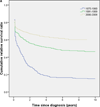Acute promyelocytic leukemia: a population-based study on incidence and survival in the United States, 1975-2008
- PMID: 22707337
- PMCID: PMC4180246
- DOI: 10.1002/cncr.27623
Acute promyelocytic leukemia: a population-based study on incidence and survival in the United States, 1975-2008
Abstract
Background: With the introduction of all-trans retinoic acid and arsenic trioxide, the management of acute promyelocytic leukemia (APL) has changed dramatically. We performed a population-based study of APL in the United States to determine its incidence and relative survival (RS) during a 34-year period.
Methods: We identified 1397 patients diagnosed with APL between 1975 and 2008 in the Surveillance, Epidemiology, and End Results database. Patients were categorized into 4 age groups and 3 calendar periods. As a comparison, we also reviewed the outcome of APL patients treated at our institution during approximately the same time interval.
Results: The incidences of APL increased with time period and patient age. Short- and long-term RS improved with each calendar period, with the greatest improvement occurring between 1991 and 1999; 5-year RS rates were 0.18 for patients diagnosed in 1975-1990, 0.52 in 1991-1999, and 0.64 in 2000-2008. Age was an important predictor of survival. For example, the 5-year RS rate in patients diagnosed in 2000-2008 was 0.38 for patients aged ≥ 60 years and 0.73 and 0.75 for patients aged <20 years and 20-39 years, respectively. Similar treads of improvements in the survival were observed in APL patients treated at our institution.
Conclusions: The incidence of APL has increased, especially in the last decade. Clinical outcome improved remarkably in patients with APL diagnosed from 1991 to 1999, mainly because of the increased use of all-trans retinoic acid.
Copyright © 2012 American Cancer Society.
Figures






References
-
- Soignet SL, Maslak P, Wang ZG, et al. Complete remission after treatment of acute promyelocytic leukemia with arsenic trioxide. N Engl J Med. 1998;339(19):1341–1348. - PubMed
-
- Yamamoto JF, Goodman MT. Patterns of leukemia incidence in the United States by subtype and demographic characteristics, 1997–2002. Cancer Causes Control. 2008;19(4):379–390. - PubMed
-
- de The H, Chen Z. Acute promyelocytic leukaemia: novel insights into the mechanisms of cure. Nat Rev Cancer. 2010;10(11):775–783. - PubMed
-
- Licht JD. Acute promyelocytic leukemia--weapons of mass differentiation. N Engl J Med. 2009;360(9):928–930. - PubMed
-
- Sanz MA, Lo-Coco F. Modern approaches to treating acute promyelocytic leukemia. J Clin Oncol. 2011;29(5):495–503. - PubMed
MeSH terms
Substances
Grants and funding
LinkOut - more resources
Full Text Sources
Research Materials

